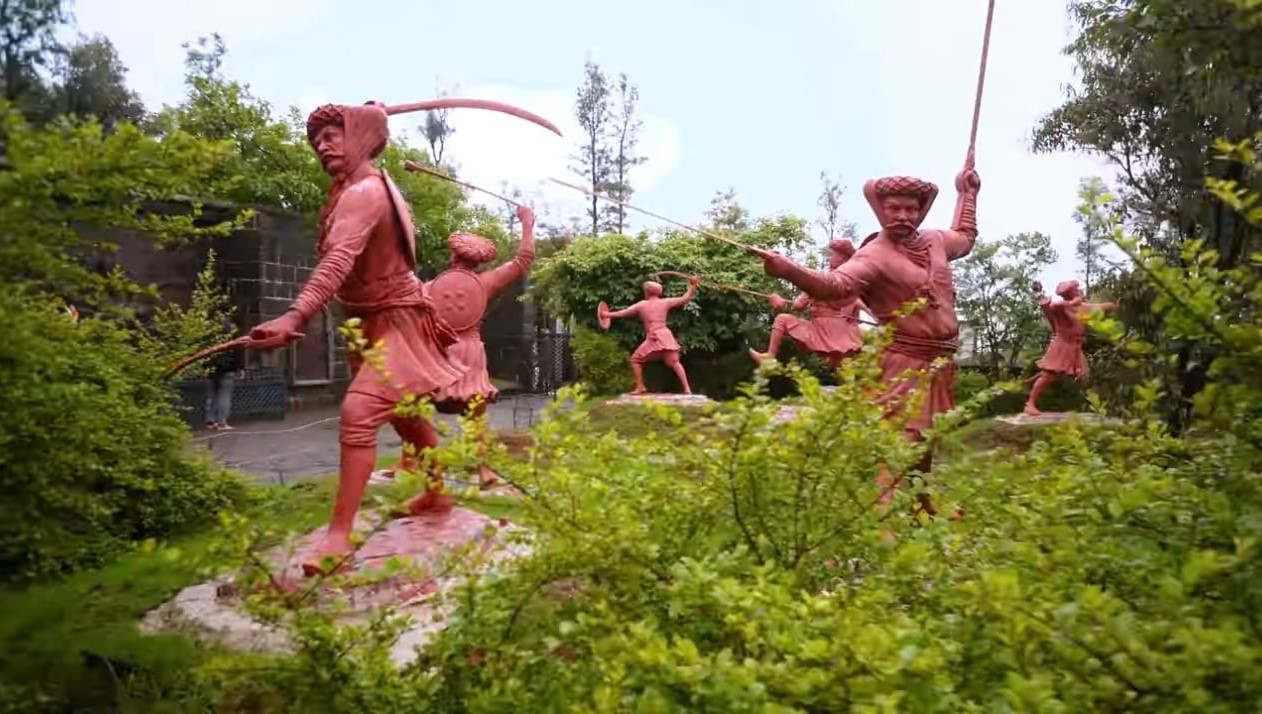Discover the magnificence of Sinhagad Fort, a historic marvel nestled in the lush landscapes of India. This comprehensive guide covers everything you need to know about this ancient fortification, from its rich history to its breathtaking views, and actual images that speak about the tales.
Introduction
Welcome to an exhilarating journey through time as we embark on an exploration of the storied past and cultural heritage of Sinhagad Fort. Nestled amidst the lush landscapes of Maharashtra, this ancient stronghold beckons history enthusiasts and adventurers alike. Brace yourself for an awe-inspiring experience as we delve into the heroic tales of valor, the strategic brilliance of great warriors, and the pivotal moments that shaped India’s rich history.
Join us as we unravel the secrets of Sinhagad Fort, a bastion of resilience and courage that echoes the footsteps of legends. From the heart-pounding battles to the intriguing architectural marvels, this article will take you on an enthralling voyage, capturing the essence of Sinhagad Fort and leaving you in awe of the enduring legacy it carries. Prepare to be enthralled by the tenacious Marathas and the extraordinary historical significance contained within the fortress’s walls.
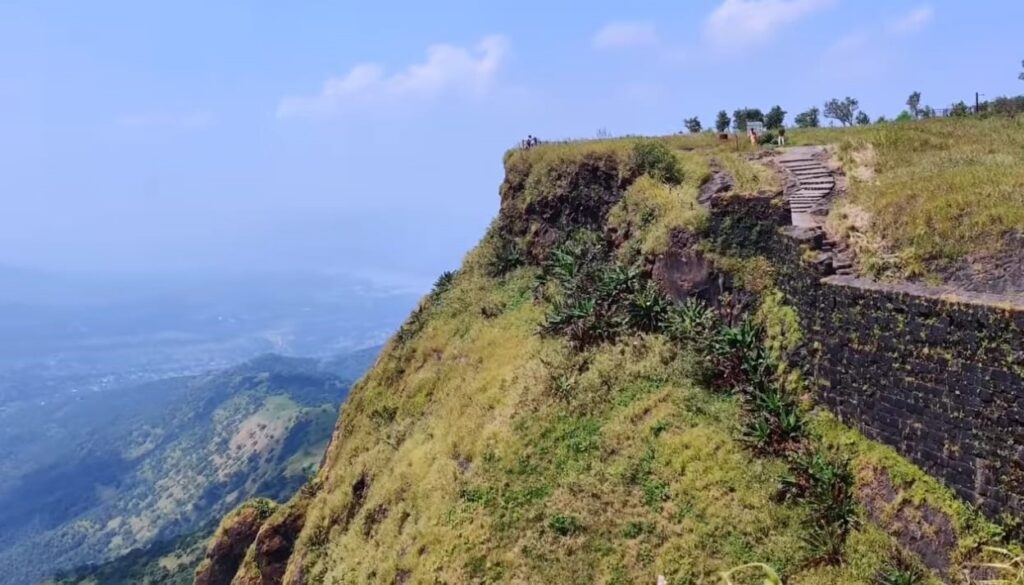
Sinhagad Fort: A Glimpse into the Past
Sinhagad Fort, also known as the Lion Fort, has a history that dates back to the 17th century. Originally, it was called “Kondhana Fort” and was under the control of various dynasties before it came into the hands of the Maratha Empire. The fort played a pivotal role in many battles and stands as a symbol of valor and strength.
The Maratha warrior, Tanaji Malusare, demonstrated unmatched courage during the Battle of Sinhagad, fighting to reclaim the fort from the Mughals. His bravery earned him the title of “Lion” or “Sinha.” Since then, the fort has been fondly known as Sinhagad Fort, honoring Tanaji’s sacrifice. Let’s explore the history of the Fort in detail before venturing into its architecture.
Pre-Shivaji Era: The Early Fortifications
The pre-Shivaji era of Sinhagad Fort is shrouded in the mists of antiquity, stretching back to the 1st century AD. During this time, the fort underwent significant developments, witnessing the rise and fall of different dynasties, each leaving their mark on its historical landscape.
Ancient Origins: The Fort’s Birth
Sinhagad Fort, originally known as “Kondhana Fort,” owes its existence to the ingenuity of ancient architects and strategists. Constructed atop a formidable hill, the fort’s location was meticulously chosen to offer a strategic advantage in the region. Perched at an altitude of approximately 1,312 meters (4,304 feet) above sea level, it commanded a sweeping view of the surrounding landscape, providing an excellent vantage point for surveillance and defense.
Early Dynastic Rule
As history unfolded, the fort came under the dominion of various dynasties. The Satavahanas, who ruled a vast empire in ancient India, were among the early custodians of Kondhana Fort. The fort served as a crucial military outpost during their reign, playing a vital role in safeguarding the trade routes and maintaining regional stability.
Chalukyas and Rashtrakutas: A Flourishing Period
In the 6th century AD, the Chalukyas, another prominent dynasty of the Deccan, assumed control of Sinhagad Fort. Under their rule, the fortifications were further strengthened, and its strategic significance grew.
In the subsequent centuries, the Rashtrakutas, who succeeded the Chalukyas, continued to enhance the fort’s defenses. The Rashtrakuta dynasty’s reign witnessed a flourishing period of art and culture, and Sinhagad Fort bore witness to the region’s architectural marvels.
Yadavas and Bahamanis: Transition of Power
The fort’s journey continued with the Yadavas taking control in the 12th century AD. Their rule marked a period of territorial disputes, and Sinhagad Fort saw multiple transitions of power.
By the 14th century AD, the Bahamani Sultanate emerged as a dominant force in the Deccan. Muhammad bin Tughlaq captured it from Nag Naik, the tribal chief of Koli people, in 1328. The fort was among the key strategic points they sought to secure, and its possession exchanged hands between the Bahamanis and other regional rulers in the subsequent years.
The Nizamshahi Rule
In the early 16th century AD, the Nizamshahi dynasty rose to prominence, consolidating its control over vast territories in the Deccan region. The Nizamshahi dynasty, also known as the Ahmadnagar Sultanate, was a prominent and influential Islamic dynasty that ruled parts of present-day Maharashtra from 1490 to 1636.
However, the Nizamshahi rule was not without challenges, as they faced conflicts with other regional powers like the Mughals and the Adil Shahi dynasty. During this period, Sinhagad Fort developed a unique connection with the Marathas.
Shivaji’s Rule: The Battle of Sinhagad
During the illustrious reign of Chhatrapati Shivaji Maharaj, Sinhagad Fort played a pivotal role in one of the most legendary battles in Indian history – the Battle of Sinhagad. This era marked a significant turning point in the fort’s history, as it witnessed the daring exploits of the Maratha warrior Tanaji Malusare and the valor of the Maratha forces.
Capturing Fort with No Battle
As Adil Shah’s commander, Shahaji Bhosale was given leadership over the Pune region. However, Shivaji, his son, refused to recognize the Adilshahi and started the process of establishing Swarajya. In 1647, he persuaded Siddi Amber, the Adilshahi Sardar in charge of the fort, to cede possession of Kondhana to him. In this effort, Bapuji Deshpande played a crucial part.
Lost and Captured: No Battle
It had to be given to Adil Shah in 1649 in exchange for the liberation of Shahaji Maharaj. With the aid of Bapuji Mudgal Deshpande, who persuaded the fort commander by promising property in the recently established Shivapur village, Shivaji Maharaj once more took possession of the fort in 1656. Mughal attacks on this fort occurred in 1662, 1663, and 1665.
Lost and Recaptured: Battle Involved
Even the Mughal general Shahistekhan attempted to buy the fort’s inhabitants to hand it over to him, but he was unsuccessful. In Purandar Pact, it was given to Mirzaraje Jaysingh, the commander of the Mughal army, in 1665. After being recaptured by Shivaji Maharaj in 1670, the fort was governed by the Maratha till 1689.
The Tussle for Sinhagad Fort
In the 17th century, the Adil Shahi Sultanate held control over Sinhagad Fort. However, Shivaji Maharaj’s vision of a united Maratha kingdom and his desire to reclaim his ancestral lands led to the decision to recapture the fort from the Sultanate.
The battle for Sinhagad Fort was not just a strategic military conquest. It served as evidence of the Maratha warriors’ constant strength and determination.. Shivaji Maharaj saw Sinhagad as a symbol of Maratha pride, and the fort’s recapture became a matter of honor and prestige.
The Legendary Nighttime Assault
In 1670, Shivaji entrusted the critical mission of capturing Sinhagad Fort to his trusted general, Tanaji Malusare. The battle is said to have taken place during the monsoon season when the fort’s defenses were perceived to be at their weakest.
Under the cover of darkness, Tanaji and a select group of courageous Maratha soldiers embarked on a daring nighttime assault. Their audacious plan involved scaling the seemingly impregnable cliffs of the fort using monitor lizards (“ghorpad” in Marathi) as ropes.
Tanaji’s Sacrifice and Victory
The Battle of Sinhagad was fierce and intense, with both sides displaying unparalleled valor. Tanaji’s heroism and indomitable spirit were instrumental in the eventual victory of the Marathas. However, victory came at a steep price.
During the battle, Tanaji was mortally wounded, and he succumbed to his injuries while still on the battlefield. His sacrifice earned him the title of “Sinha” or “Lion,” and he became forever immortalized as “Sinha-gad,” the fort captured by a lion.
Post-Shivaji Era: Changing Hands
After the demise of the illustrious Chhatrapati Shivaji Maharaj, Sinhagad Fort witnessed a period of transition as it changed hands multiple times. The post-Shivaji era was marked by shifting powers and turbulent times, each leaving its mark on the fort’s historical landscape.
The Decline of the Maratha Empire
Following the passing of Shivaji Maharaj, the Maratha Empire faced internal strife and power struggles. The lack of a strong central authority led to a gradual weakening of the empire’s grip over its territories, including Sinhagad Fort.
As the empire grappled with its internal challenges, rival factions and neighboring kingdoms saw an opportunity to assert their dominance in the region.
The Final British Conquest
In the early 18th century, the British East India Company emerged as a dominant force in India, actively pursuing territorial expansion. Sinhagad Fort became a target in their quest to assert control over the Deccan.
In 1818, after a protracted campaign, the British East India Company finally captured Sinhagad Fort. This marked the end of its significance as a military stronghold and ushered in a new chapter in the fort’s history.
Present: A Historic Marvel and Tourist Attraction
Today, Sinhagad Fort stands as a historic marvel, drawing tourists and history enthusiasts from around the world. Its ancient ruins, grand entrance gates, and watchtowers offer a glimpse into the glorious past. The fort’s captivating beauty, coupled with its panoramic views of the Sahyadri mountain range, make it a popular destination for nature lovers and adventure seekers alike.
The fort’s historical significance has also led to its conservation and maintenance efforts by the Indian government and local authorities. While the military importance has diminished over the centuries, the fort’s cultural and heritage value remains intact.
Exploring the Architecture of Sinhagad Fort
As you set foot on the ancient grounds of Sinhagad Fort, you’ll be transported back in time. The fort’s architecture reflects the grandeur of its bygone era. The remnants of historical structures, including gates, bastions, and temples, evoke a sense of nostalgia and wonder.
The Magnificent Gates
One of the first things that will capture your attention is the majestic entrance. The fort boasts of two prominent gates, each with its significance and charm. Kalyan Darwaza in the southeast and Pune Darwaza in the northeast are its two gates.
Pune Darwaza is the main gate of the Fort. Kalyan Darwaza played an important role in the Battle of Sinhagad. Amidst the intense Battle, Tanaji Malusare’s strategic brilliance shone through as he successfully scaled the treacherous cliffs and reached the top of the fort. Displaying exceptional valor and foresight, Tanaji promptly opened the Kalyan Darwaza, the majestic gate of Sinhagad Fort. By unlocking the Kalyan Darwaza, Tanaji paved the way for his fellow companions to enter the fort and take a strong stand in the ongoing fight. This tactical maneuver not only showcased his leadership skills but also enabled the Maratha forces to reinforce their positions and confront the enemy head-on.
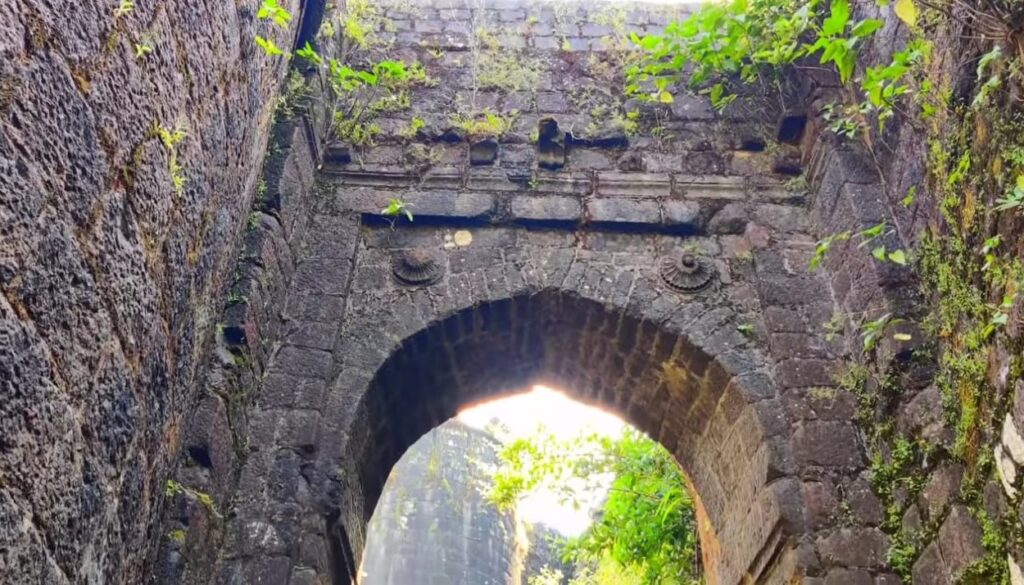
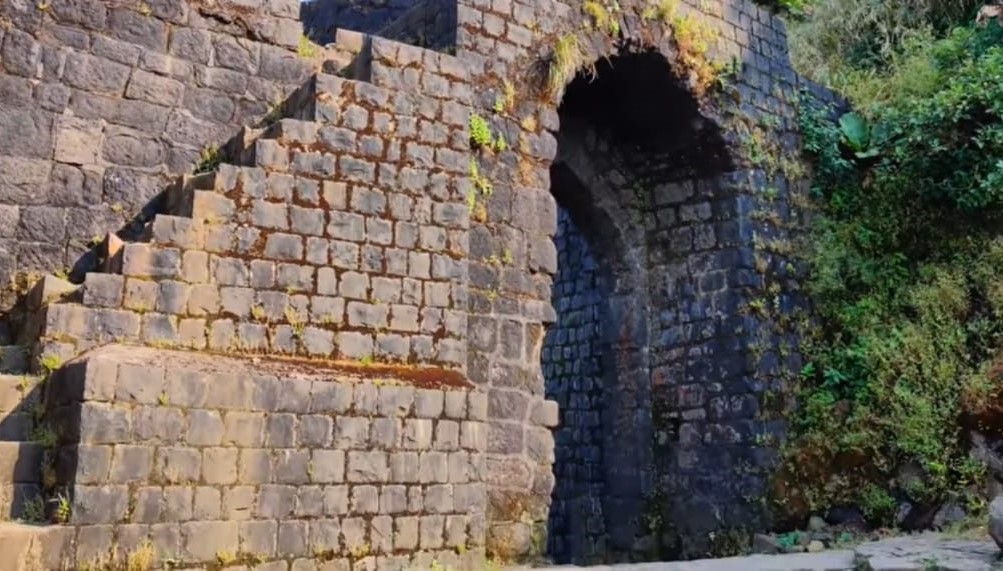
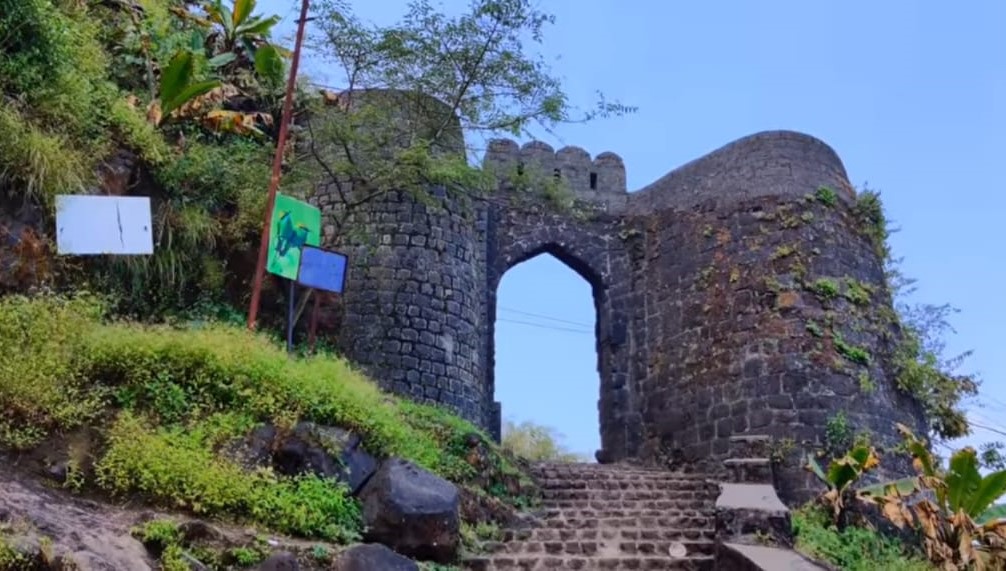

Daru Golyache Kothaar
“Daru Golyache Kothaar,” also known as the Cannonball Storage Warehouse served as a vital repository for cannonballs during the fort’s heyday as a military stronghold. As a formidable defensive bastion, Sinhagad Fort required a steady supply of ammunition to protect its territory and fend off adversaries. The “Daru Golyache Kothaar” played a crucial role in storing and safeguarding the cannonballs, ensuring they were readily available during times of conflict.
Within the walls of this ancient warehouse, the cannonballs would be meticulously arranged, ready to be loaded into the cannons and unleashed upon any approaching enemy. The strategic placement of the “Daru Golyache Kothaar” ensured that the defenders had quick access to the ammunition, enabling them to respond swiftly to any threat to the fort.
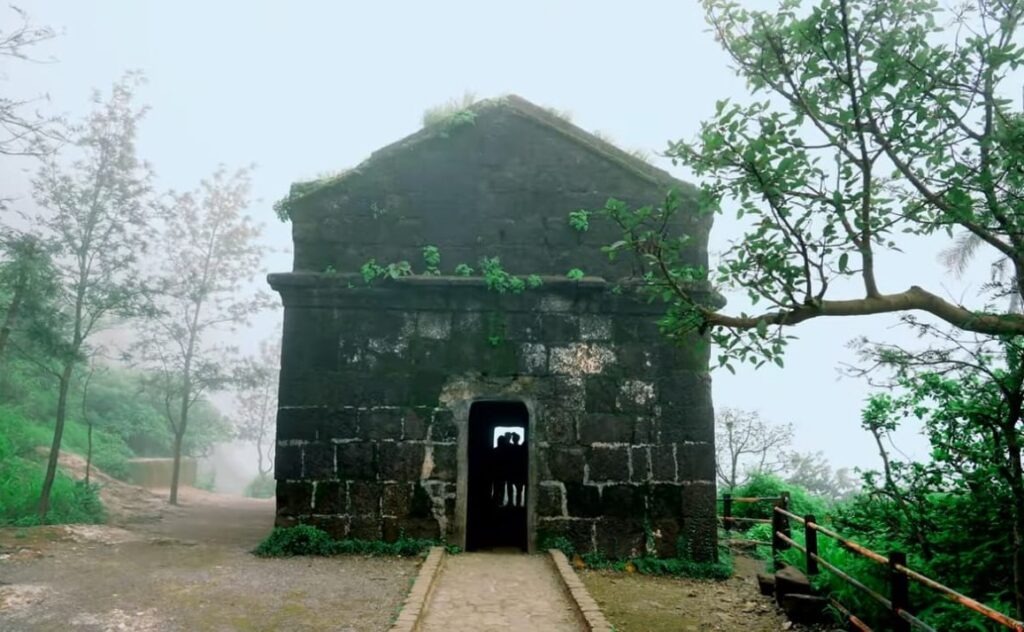
Holy Temples
Sinhagad Fort houses two significant temples that hold deep religious importance for the locals and visitors alike. Amruteshwar Mandir, dedicated to the local deity of the Kolis, is a sacred place of worship where devotees seek blessings and spiritual solace. Another prominent temple on the fort is Kondansehwar Temple, devoted to Lord Shiva.
Both temples add a touch of spirituality to the historical charm of Sinhagad Fort, making it a captivating destination for those seeking cultural and religious experiences.

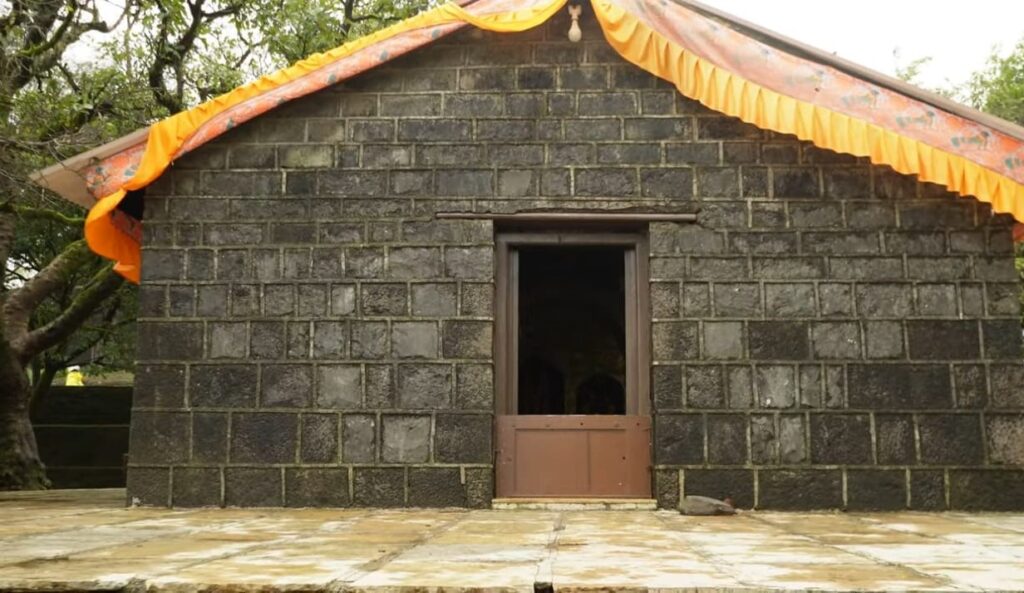

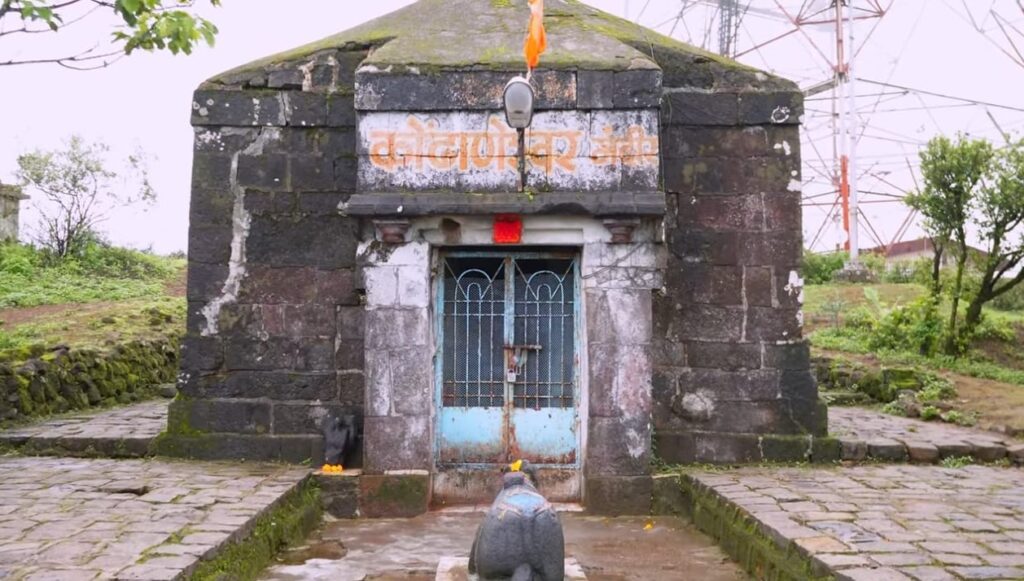
Ghodyanchi Paaga
Ghodyanchi Paaga, an intriguing structure on Sinhagad Fort, adds a touch of historical charm to the ancient stronghold. Translating to “Horse Stable” in English, this architecture once served as a stable for horses, showcasing the strategic importance of the fort as a military outpost.
Today, while the horses are long gone, Ghodyanchi Paaga stands as a well-preserved relic, inviting visitors to step back in time and imagine the gallant steeds that once occupied this historical structure.

Samadhis
Sinhagad Fort bears witness to the final resting places of two illustrious figures in Indian history – Tanaji Malusare Samadhi and Rajaram Maharaj Samadhi.
Tanaji Malusare, the valiant Maratha warrior, who displayed unparalleled courage during the Battle of Sinhagad, was laid to rest on this historic site. His samadhi stands as a tribute to his heroism, sacrifice and his endeavor to reclaim the fort.
Rajaram Maharaj, the younger brother of Chhatrapati Shivaji Maharaj, also found his eternal abode on Sinhagad Fort. Rajaram Maharaj’s samadhi holds a special significance, reflecting the fort’s historical importance during the Maratha rule.
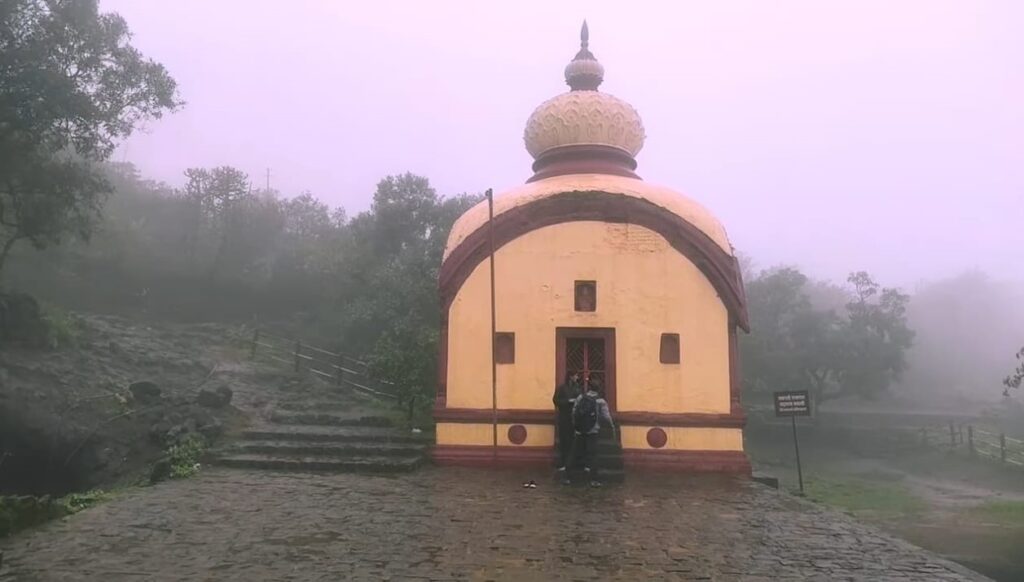


Tanaji’s Hand Memorial
During the intense Battle of Sinhagad, Tanaji found himself in a precarious situation when his shield broke amidst the heat of combat. Undeterred and swift in his response, he improvised, wrapping his pheta and paagoti (headgear made up of cloth) around his hand to create a makeshift shield. With this impromptu defense, he bravely bore the assaults of the enemy, displaying unending resilience.
The ongoing fight took a toll, and Tanaji lost his hand in the heat of the battle. Yet, undaunted, he continued to fight, demonstrating an unparalleled commitment to the cause he held dear.
The very spot where he valiantly lost his hand now serves as a memorial, commemorating his courage and sacrifice. This poignant memorial on Sinhagad Fort stands as a testimony to Tanaji Malusare’s steadfast spirit and the Marathas’ commitment to defending their country.
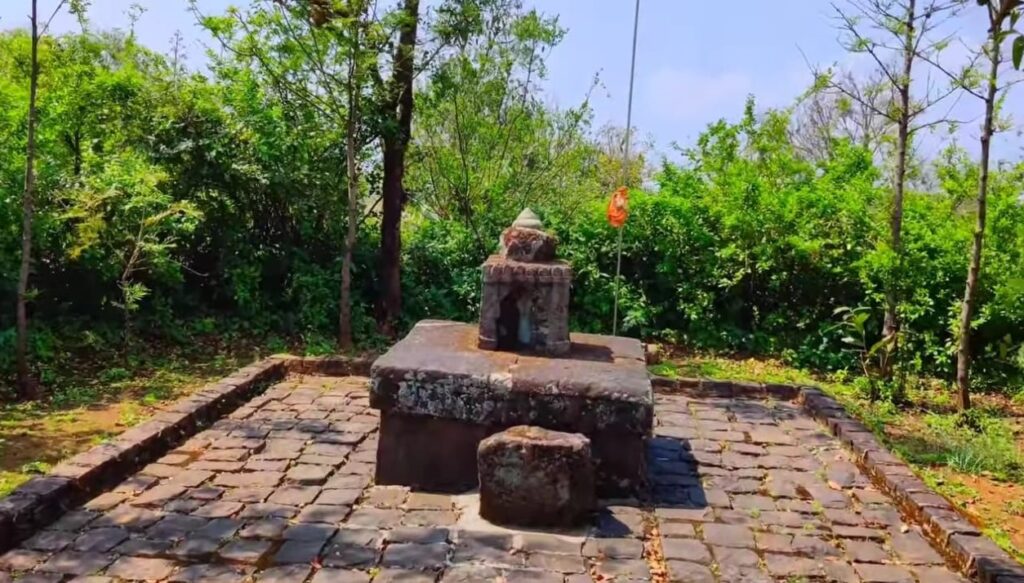
Fighting Pose Statues
The memory of the iconic Battle of Sinhagad and the valorous Tanaji Malusare finds immortalization in the form of striking statues atop the historic fort. These statues are not mere standalone monuments. instead, they are masterfully crafted to depict the dynamic and intense moments of the actual battle. Placed in a dramatic fighting pose.
Tanaji Malusare and his companions come to life, offering a glimpse into the fierce and spirited combat that once unfolded on these very grounds. The exquisite artistry and attention to detail in these statues serve as a powerful tribute to the bravery and sacrifice of the warriors who fought to defend Sinhagad Fort.

Tanaji Kadhaa
During the epic Battle of Sinhagad, the valiant Tanaji Malusare demonstrated extraordinary bravery and tactical prowess by employing a daring strategy. To scale the steep cliffs and breach the fort’s defenses, Tanaji sought the aid of a local reptile called “ghorpad” or monitor lizard. Using the ghorpad’s natural climbing abilities, Tanaji climbed a treacherous part of the mountain with great agility and determination.
This remarkable feat of courage and ingenuity took place on a specific section of the mountain, which came to be known as “Dronagiricha Kadhaa” or “Tanaji Kadhaa” in honor of his daring ascent.

Tilak Bungalow
Tucked amidst the historical grandeur of Sinhagad Fort, the quaint 1890 Lokmanya Tilak Bungalow holds a significant place in the life of the great freedom fighter, Lokmanya Bal Gangadhar Tilak. Purchased by Lokmanya Tilak, this bungalow served as his serene resting place during the summer seasons when he sought moments of leisure.
It was within the tranquil walls of this bungalow that Tilak completed the writing of his seminal book, “The Arctic Home in the Vedas,” during the months of May and June in 1901. Moreover, it was on this very site that the first print of his influential work, “Geeta Rahasya,” was prepared in 1915.
Additionally, history witnessed the momentous meeting of two stalwarts of the freedom movement, Mahatma Gandhi and Lokmanya Tilak, as they gathered at this very bungalow. This remarkable abode stands as a cherished reminder of the meetings of great minds and the intellectual pursuits of one of India’s most revered leaders.

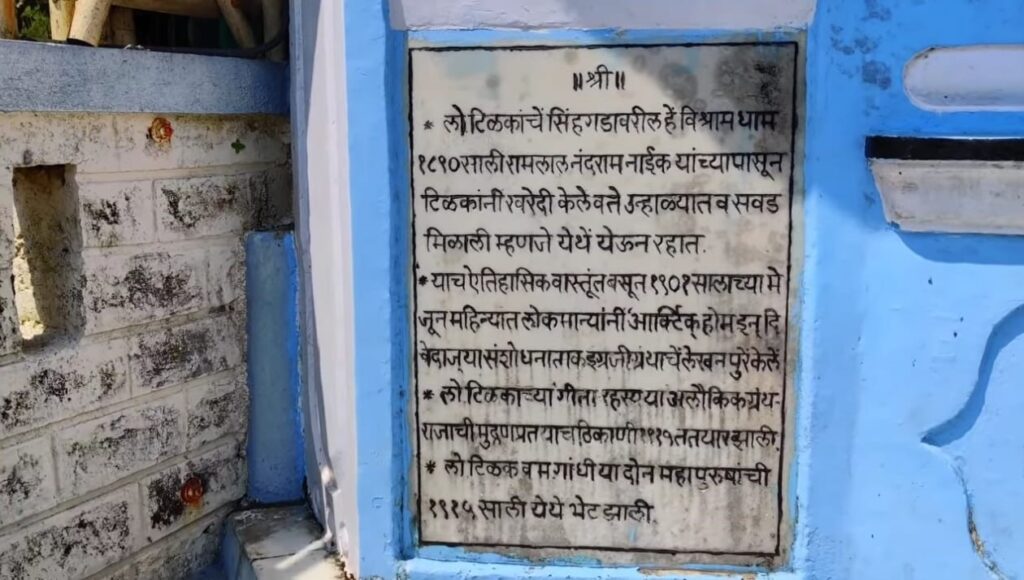
Frequently Asked questions (FAQ)
Who built Sinhagad Fort?
Sinhagad Fort’s exact origins remain shrouded in history, but it is believed to have been initially constructed during the Satavahana dynasty’s rule.
How did Sinhagad Fort get its name?
The fort derives its name “Sinhagad” from the Marathi words “Sinha” (Lion) and “Gad” (Fort), symbolizing its strength and valor.
Which dynasties ruled over Sinhagad Fort?
Sinhagad Fort witnessed the rule of various dynasties, including the Satavahanas, Chalukyas, Rashtrakutas, Yadavas, and Bahmanis.
What is the significance of Tanaji Malusare in Sinhagad Fort’s history?
Tanaji Malusare, a brave Maratha warrior, played a pivotal role in the Battle of Sinhagad, displaying exceptional courage and tactical prowess.
Are there any ancient temples within Sinhagad Fort?
Yes, Sinhagad Fort houses ancient temples such as Kondaneswar Mandir and Amruteshwar Mandir, reflecting the spiritual and cultural heritage of the region
What architectural features make Sinhagad Fort unique?
Sinhagad Fort’s architecture showcases a blend of military fortifications, gates like Pune Darwaza, and structures like the “Daru Golyache Kothaar” (Cannonball Storage Warehouse)
When did Lokmanya Tilak own the Tilak Bungalow on Sinhagad Fort?
Lokmanya Tilak acquired the Tilak Bungalow in 1890, using it as a rest place during his leisure time and for significant literary works.
What is the historical importance of the Tanhaji Kadhaa on Sinhagad Fort?
Tanaji ascended a dangerous area of the mountain with amazing agility and determination, using the ghorpad’s innate climbing ability to enter Sinhagad Fort during the battle.
An area of the mountain where this amazing act of bravery and resourcefulness occurred became called as “Dronagiricha Kadhaa” or “Tanaji Kadhaa” in recognition of his heroic ascension.
Conclusion
In conclusion, the journey through the captivating history of Sinhagad Fort has been nothing short of a remarkable odyssey. From its early dynastic rule under the Satavahanas to the flourishing periods of the Chalukyas and Rashtrakutas, and the transitions of power during the Yadavas and Bahmanis, the fort has borne witness to the rise and fall of mighty dynasties. Through the annals of time, Sinhagad Fort has stood as an embodiment of bravery, resilience, and strategic brilliance, as showcased by the heroic exploits of Tanaji Malusare during the Battle of Sinhagad.
Whether you seek to revel in the tales of bygone eras, soak in the breathtaking views of the Sahyadri ranges, or simply connect with the essence of history, Sinhagad Fort promises an experience that lingers in your heart forever. As the sun sets on this unforgettable expedition, may the echoes of the past continue to inspire and remind us of the valor and sacrifices of those who once tread these hallowed grounds.
